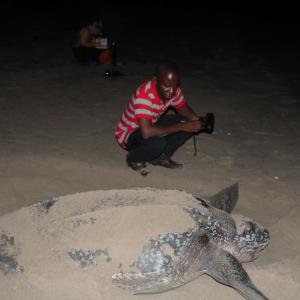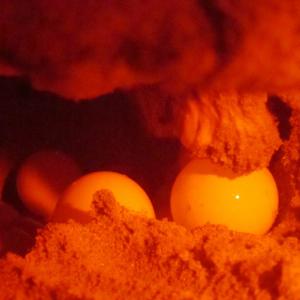Social media video festuring the project.
Sea Turtles of Ghana
Sea Turtle By-Catch Reduction and Nesting Habitat Protection in Cape Coast, Ghana
This project aims at halting the poaching of sea turtles and the degradation of their habitats in the Cape Coast and Elmina area of Ghana by engaging coastal communities to protect their beaches and turtles. Major state stakeholders in environmental protection will also be engaged in order to develop an action plan for conservation of sea turtles in the area.

Nesting leatherback turtle during field training and turtle monitoring at Mankoadze. ©Dan Barbour
Historically, five species of marine turtles are known to nest along Ghana’s beaches (deGraft-Johnson et al, 2010). These are the Leatherback (Demochelys coriacea), Hawksbill (Eretmochelys sp.), Green turtle (Chelonia mydas), Loggerhead (Caretta caretta) and Olive-Ridley (Lepidochelys olivacea). Sighting of nesting turtles along most beaches in Ghana are becoming rare (Tanner, 2013; Boateng, 2006) most likely due to severe land-based threats that the turtles face when they visit the beaches to nest. Along the Cape Coast and Elmina area, marine turtles face two major threats from coastal communities in the form of poaching and the destruction of nesting habitats through beach sand mining (Jonah, 2014).

Eggs of an Olive Ridley as she nested at Mankoadze during field training of F. Jonah. ©F. Jonah
Little research has been conducted about the status of sea turtles in the Cape Coast and Elmina area making planning for conservation a challenge. Poaching of turtles and their eggs therefore go on without the detection and knowledge of appropriate authorities such as the Ghana Wildlife Service. Beach sand mining activities along most beaches in the area also compounds the fate of the turtles as many potential nesting areas have become degraded and starved of sand. This project seeks to:
1. identify the current sea turtle species that nest in the Cape Coast and Elmina area and their actual nesting sites
2. engage coastal communities to protect nesting sea turtles
3. engage state stakeholders to develop an action plan for sea turtles and habitat conservation.
Background information about sea turtles will be obtained from coastal communities through administration of a set of structured questionnaire, a series of focus ground interviews and one-on-one interactions. A trainer of trainees’ workshop on turtle conservation will be organized for key community leaders, who will be expected to pass on their acquired knowledge to their respective communities. With the aid of volunteers in the various communities, a continuous sea turtle patrol regimen will be developed to promote sighting of nesting turtles for protection. Also, a series of stakeholder dialogue meetings will be organized with the support of the Cape Coast Metropolitan Assembly to develop a sea turtle conservation action plan for the area.
It is expected that at the end of the project community members will have developed an interest in sea turtle conservation which they can use to improve their livelihoods through promotion of ecotourism. Also, we expect that enforcements of environmental regulations will be improved to stop the degradation of habitat and poaching of turtles.